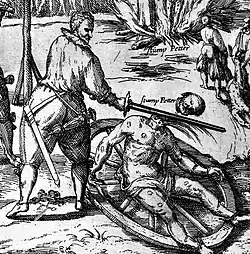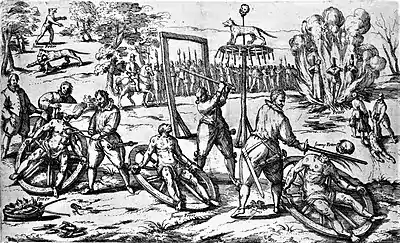Peter Stumpp
Peter Stumpp (c. 1535 - 1589; name is also spelled as Peter Stube, Peter Stubbe, Peter Stübbe or Peter Stumpf) was a German serial killer and farmer, accused of werewolfery, witchcraft and cannibalism. He was known as 'the Werewolf of Bedburg'.
Peter Stumpp | |
|---|---|
 Woodcut showing the beheading of Peter Stumpp in Cologne in 1589 | |
| Born | Peter Stumpp c. 1535 Bedburg, Germany |
| Died | 31st October 1589 (aged c. 55) Cologne, Germany |
| Cause of death | Execution by breaking |
| Other names | The Werewolf of Bedburg / Peter Stumpf |
| Criminal penalty | Death by Breaking |
| Details | |
| Victims | 18 |
Span of crimes | c. 1564–1589 |
| Country | Holy Roman Empire |
| State(s) | Electorate of Cologne |
Date apprehended | 1589 |
Sources
The most comprehensive source on the case is a pamphlet of 16 pages published in London in 1590, the translation of a German print of which no copies have survived. The English pamphlet, of which two copies exist (one in the British Museum and one in the Lambeth Library), was rediscovered by occultist Montague Summers in 1920. It describes Stumpp's life, alleged crimes and the trial, and includes many statements from neighbours and witnesses of the crimes.[1] Summers reprints the entire pamphlet, including a woodcut, on pages 253 to 259 of his work The Werewolf.
Additional information is provided by the diaries of Hermann von Weinsberg, a Cologne alderman, and by a number of illustrated broadsheets, which were printed in southern Germany and were probably based on the German version of the London pamphlet. The original documents seem to have been lost during the wars of the centuries that followed.
Contemporary reference was made to the pamphlet by Edward Fairfax in his firsthand account of the alleged witch persecution of his own daughters in 1621.[2]
Life and career
Although the exact date and place of Peter Stumpp's birth is unknown, examining sources likely puts it near Bedburg, Germany around 1530.[3] Stumpp's name is also spelled as Peter Stube, Peter Stub,[2] Peter Stubbe, Peter Stübbe or Peter Stumpf, and other aliases include such names as Abal Griswold, Abil Griswold, and Ubel Griswold. The name "Stump" or "Stumpf" may have been given him as a reference to the fact that his left hand had been cut off leaving only a stump, in German "Stumpf". It was alleged that as the "werewolf" had its left forepaw cut off, then the same injury proved the guilt of the man. Stumpp was born at the village of Epprath near the country-town of Bedburg in the Electorate of Cologne. His actual date of birth is not known, as the local church registers were destroyed during the Thirty Years' War (1618–1648). He was a wealthy farmer of his rural community.[4] During the 1580s, he seems to have been a widower with two children; a girl called Beele (Sybil), who seems to have been older than fifteen years old, and a son of an unknown age.
Accusations
During 1589, Stumpp had one of the most lurid and famous werewolf trials of history. After being stretched on a rack, and before further torture commenced,[5] he confessed to having practiced black magic since he was twelve years old. He claimed that the Devil had given him a magical belt or girdle, which enabled him to metamorphose into "the likeness of a greedy, devouring wolf, strong and mighty, with eyes great and large, which in the night sparkled like fire, a mouth great and wide, with most sharp and cruel teeth, a huge body, and mighty paws." Removing the belt, he said, made him transform back to his human form. No such belt was ever found after his arrest.
For twenty-five years, Stumpp had allegedly been an "insatiable bloodsucker" who gorged on the flesh of goats, lambs, and sheep, as well as men, women, and children. Being threatened with torture he confessed to killing and eating fourteen children, two pregnant women, whose fetuses he ripped from their wombs and "ate their hearts panting hot and raw,"[4] which he later described as "dainty morsels."[6] One of the fourteen children was his own son, whose brain he was reported to have devoured.
Not only was Stumpp accused of being a serial murderer and cannibal, but also of having an incestuous relationship with his daughter,[4] who was sentenced to die with him, and that he had coupled with a distant relative, which was also considered to be incestuous according to the law. In addition to this he confessed to having had intercourse with a succubus sent to him by the Devil.
Execution
The execution of Stumpp, on 31 October 1589, alongside his daughter Sybil and mistress, Katherine, is one of the most brutal on record: he was put to a wheel, where "flesh was torn from his body", in ten places, with red-hot pincers, followed by his arms and legs. Then his limbs were broken with the blunt side of an axehead to prevent him from returning from the grave, before he was beheaded and his body burned on a pyre. His daughter and mistress had already been flayed and strangled, and were burned along with Stumpp's body. As a warning against similar behavior, local authorities erected a pole with the torture wheel and the figure of a wolf on it, and at the very top they placed Peter Stumpp's severed head.[3]
In popular culture
- The U.S. metal band Macabre recorded a song about Peter Stumpp, titled "The Werewolf of Bedburg"; it can be found on the Murder Metal album.
- The German horror punk band The Other recorded a song about Peter Stumpp, titled "Werewolf of Bedburg" on their Casket Case album.
- In the Pine Deep Trilogy of novelist and folklorist Jonathan Maberry, Peter Stumpp is the supernatural villain Ubel Griswold. Since Griswold is actually one of Stumpp's historical aliases, Maberry decided to use the name of Ubel Griswold instead of openly telling people that the villain was the infamous werewolf Peter Stumpp until later on in the third book of the series, Bad Moon Rising.
- A reference to Peter Stumpp is also made in William Peter Blatty's book, The Exorcist. When Father Karras and Kinderman talk about Satanism they say "Terrible, was this theory, Father, or fact?" "Well, there's William Stumpf, for example. Or Peter. I can't remember. Anyway, a German in the sixteenth century who thought he was a werewolf".
- The direct-to-video Big Top Scooby-Doo!, uses a portion of Lukas Mayer's woodcut of the execution of Stumpp in 1589, though in the movie no mention of Stumpp is made. The portion used depicts a man cutting off a werewolf's left paw (supposedly Stumpp in werewolf form) and a child being attacked by a werewolf. The woodcut scene shown in the film restores the werewolf's left paw and removes the child in the second werewolf's jaws, making it appear as if the swordsman is fighting one of the werewolves while another flees.
- In the Doctor Who audio drama Loups-Garoux, Pieter Stubbe was in fact a werewolf. He managed to escape before he was executed and lived for another five centuries. He was defeated by the Fifth Doctor in Brazil in 2080. It is implied that he ate both the Grand Duchess Anastasia and Lord Lucan.
- Journalist and fiction writer J. E. Reich partially based her short story "The Werewolves of Anspach" on the life of Peter Stumpp.[7]
- The story of Peter Stumpp was also told in episode 3 of the podcast Lore, released on April 6, 2015. In 2017, the podcast episode was adapted into the fifth episode of the TV series adaptation of Lore, where he was played by Adam Goldberg.
References
Notes
- Orenstein, Catherine (2002) Little Red Riding Hood Uncloaked: Sex, Morality, and the Evolution of a Fairy Tale. New York: Basic Books. p. 91, ISBN 0-465-04125-6
- Fairfax, Edward (1882) Daemonologica: A Discourse on Witchcraft. Harrogate:R. Ackrill. p.97
- "PETER STUMPP: THE WEREWOLF OF BEDBURG". The Dark History Podcast. Retrieved October 19, 2020.
- Blundell, Nigel (1997) Encyclopedia of Serial Killers. Promotional Reprint Co. ISBN 1-85648-328-2 p.165
- Friedrich, Otto (1976). Going crazy: An Inquiry into Madness in our Time (2nd prt. ed.). New York: Simon and Schuster. p. 48. ISBN 0-671-22174-4.
- Wagner, Stephen. "The Werewolf of Bedburg". Archived from the original on 2013-09-21.
- "TheWerewolvesofAnspach". littlefiction.com. Archived from the original on 2017-11-13.
Further reading
- Anonymous (1590) A True Discourse. Declaring the Damnable Life and Death of One Stubbe Peeter, a Most Wicked Sorcerer. London. (original English version).
- Everitt, David (1993) Human Monsters: An Illustrated Encyclopedia of the World's Most Vicious Murderers New York: McGraw-Hill. pp. 15–18 ISBN 0-8092-3994-9
- Farson, Daniel and Hall, Angus (1975) Mysterious Monsters- pg.53-4.
- Argues for Peter Stumpp being innocent
- Kremer, Peter (2003) "Plädoyer für einen Werwolf: Der Fall Peter Stübbe", in Wo das Grauen lauert. Blutsauger und kopflose Reiter, Werwölfe und Wiedergänger an Inde, Erft und Rur. Dueren. pp. 247–270. ISBN 3-929928-01-9
- Punset, Eduardo (2006) "El alma está en el cerebro" (punto de lectura) Redes RTVE.
- Sidky, Homayun (1997) Witchcraft, Lycanthropy, Drugs, and Disease: An Anthropological Study of the European Witch-Hunts. New York. pp. 234–238. ISBN 0-8204-3354-3.
- Various (2009) "The Bogeyman's Gonna Eat You: Albert Fish, The Vampire of Brooklyn". America's Serial Killers: Portraits in Evil Mill Creek Entertainment.

